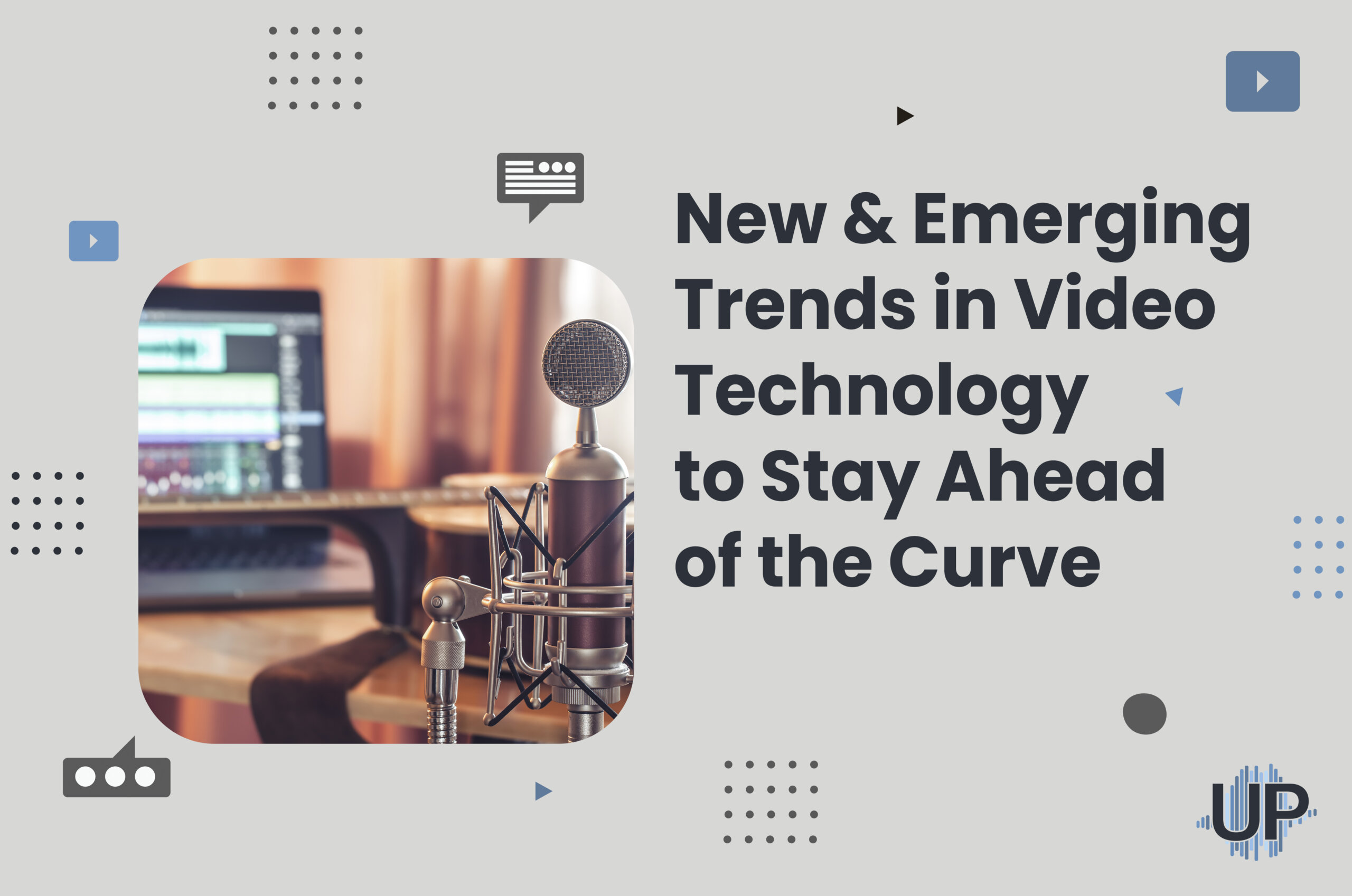
Over the years, video technology has undergone a remarkable transformation. From the grainy, black-and-white footage of the early 20th century to today’s immersive 8K, high-definition video content, the evolution has been nothing short of revolutionary. Video has become an essential medium for communication, entertainment, education, and business. The rapid advancements in video resolution, streaming capabilities, and interactive formats have paved the way for new possibilities and applications that were once unimaginable.
In this fast-paced digital age, staying updated with the latest trends in video technology is not just advantageous—it’s crucial. Businesses, content creators, and consumers alike must adapt to cutting-edge innovations, such as augmented reality (AR), virtual reality (VR), and AI-driven video analytics, to remain competitive. Embracing these emerging trends in video technology can enhance user experience, streamline operations, and open doors to new markets. This article will explore the new and emerging trends shaping the future of video technology and why keeping up with these innovations is key to staying ahead of the curve.
Trend 1: 8K Resolution
As one of the most significant developments in video technology, 8K resolution is redefining visual clarity and immersive viewing experiences. With a pixel count of 7680×4320, 8K offers four times the resolution of 4K and sixteen times that of standard HD, resulting in unparalleled sharpness and detail. This higher resolution is particularly advantageous for industries such as filmmaking, gaming, and sports broadcasting, where every detail matters. For example, major sporting events like the Olympics and FIFA World Cup have begun experimenting with 8K broadcasts to provide viewers with the most lifelike experience possible. Additionally, filmmakers such as James Cameron are pushing the boundaries of what’s possible in cinema by incorporating 8K technology into their productions. As more 8K-compatible devices like TVs and cameras enter the market, staying updated with this trend is crucial for professionals looking to deliver next-level content and for consumers eager to enjoy the highest quality viewing experience available.
Trend 2: Virtual Reality (VR) and Augmented Reality (AR)
Virtual Reality (VR) and Augmented Reality (AR) are transforming the way users interact with video content by blending the physical and digital worlds. VR immerses viewers in a completely virtual environment, making it ideal for applications like gaming, training simulations, and virtual tours. On the other hand, AR enhances real-world surroundings by overlaying digital elements, which has been widely adopted in industries like retail, education, and entertainment. For example, platforms like YouTube and Facebook are now supporting 360-degree VR videos, allowing users to explore content in a more interactive and engaging way. AR has also gained popularity with apps like Pokémon GO and the use of AR filters on Instagram and Snapchat. As VR and AR technologies continue to advance, content creators and businesses must stay ahead of these trends to deliver immersive, interactive experiences that resonate with modern audiences.
Trend 3: Artificial Intelligence (AI) in Video Production
Artificial Intelligence (AI) is revolutionizing video production by automating tasks that once required significant time and effort, allowing creators to focus on storytelling and creativity. AI-powered tools can now assist with video editing, scene detection, and even generating entire scripts. Platforms like Adobe Premiere Pro and Runway are integrating AI to streamline the editing process, suggesting cuts, transitions, and effects based on content analysis. AI can also enhance personalization, such as using machine learning algorithms to recommend video clips or formats that resonate most with specific audiences. Additionally, AI-driven analytics tools are helping businesses optimize video content for higher engagement by predicting what types of visuals or storytelling techniques are likely to capture viewers’ attention. As AI continues to evolve, its role in video production will only grow, making it essential for content creators and professionals to stay informed about these cutting-edge capabilities.
Trend 4: 360-Degree and Immersive Video
360-degree and immersive video is taking audience engagement to new heights by allowing viewers to explore content from every angle, creating a more dynamic and interactive experience. This technology lets users navigate within a video, offering a sense of presence that traditional flat videos simply can't match. It’s becoming increasingly popular in industries like real estate, travel, and education, where virtual tours and immersive storytelling can significantly enhance the user experience. For example, travel companies are using 360-degree videos to give potential customers virtual tours of destinations, while educational platforms are adopting immersive video to create interactive learning environments. As the demand for more engaging and exploratory content grows, 360-degree video is quickly becoming a go-to tool for creators looking to captivate their audiences.
Trend 5: 5G is Transforming Video Technology
The rollout of 5G networks is revolutionizing video technology by enabling faster, more reliable streaming and seamless real-time video experiences. With significantly reduced latency and lightning-fast download speeds, 5G allows users to stream high-quality content, including 4K and 8K videos, without buffering issues. This technology is also a game-changer for live streaming, making it possible to broadcast events, conferences, and concerts with unparalleled clarity and responsiveness. Moreover, 5G is powering the growth of technologies like virtual reality (VR), augmented reality (AR), and 360-degree video, providing the bandwidth necessary for smooth, immersive experiences on mobile devices. As 5G networks continue to expand, businesses and content creators will need to adapt to the enhanced capabilities this technology offers, ensuring they stay ahead of the curve in delivering high-quality, on-demand video content to an increasingly mobile and connected audience.
Trend 6: Deepfakes and Synthetic Media
Deepfakes and synthetic media are rapidly emerging as both innovative tools and challenges in the world of video technology. Using advanced AI, deepfake technology can create hyper-realistic videos by swapping faces, mimicking voices, or generating entirely synthetic people. While this can be used for entertainment, marketing, and creative projects—such as bringing historical figures to life or enhancing special effects—there are also ethical concerns surrounding misinformation and authenticity. Companies like Synthesia and Rephrase.ai are exploring the positive applications of synthetic media, enabling businesses to produce personalized, scalable video content without needing live actors. As this technology evolves, staying aware of both its opportunities and risks will be crucial for content creators, marketers, and businesses aiming to stay ahead of the curve while ensuring responsible use of these powerful tools.
Trend 7: Cloud-Based Video Services
Cloud-based video services are transforming the way video content is stored, edited, and distributed, offering unmatched flexibility and scalability for creators and businesses alike. These platforms allow users to access video files from anywhere, collaborate in real time, and streamline workflows without the need for high-end hardware. For example, services like Adobe Creative Cloud and Frame.io enable teams to collaborate on video projects remotely, while platforms like Vimeo and Wistia provide seamless video hosting, analytics, and distribution. By leveraging the cloud, creators can save time and resources, scaling their operations to meet growing demands. As more businesses and content creators turn to cloud-based solutions, staying informed about these services can help ensure you're utilizing the latest technologies to simplify production and optimize video delivery.
Trend 8: Emergence of Interactive Video Platforms
Interactive video platforms are reshaping the way viewers engage with content by allowing them to actively participate rather than passively watch. These platforms enable features such as clickable hotspots, quizzes, branching storylines, and real-time decision-making, making the viewing experience far more engaging. For instance, platforms like WIREWAX and Kaltura provide tools that allow creators to add interactive elements to videos, giving users the power to control the narrative or explore different product features in a more personalized way. This trend is particularly valuable for e-learning, marketing, and entertainment, where user engagement is key to delivering impactful experiences. As interactive video continues to grow, staying ahead of this trend can help businesses create more dynamic content that captures and holds the audience’s attention.
Trend 9: Podcasts in the Video Tech Industry
Podcasts are becoming a powerful tool in the video tech industry, blending the reach of audio content with the growing trend of video-based conversations. Video podcasts, or “vodcasts,” allow businesses to create engaging, informative discussions around the latest trends and innovations in the industry, helping to build authority and connect with their audience on a deeper level. Many tech professionals are turning to podcasts to share their expertise, highlight emerging trends, and offer insights into the future of video technology. For those considering starting a podcast, the benefits are substantial—building credibility, expanding networks, and driving business growth. If you're interested in leveraging the power of podcasts in your video strategy, check out this article on the 8 Reasons to Start a B2B Podcast. It provides practical insights on how podcasts can enhance your reach in the evolving video tech landscape.
Trend 10: Mobile Video Content
Mobile video content continues to dominate as one of the most significant trends in the video tech industry. With smartphones becoming the primary device for content consumption, businesses and creators are increasingly optimizing videos for mobile viewing. Platforms like TikTok, Instagram Reels, and YouTube Shorts are leading the charge by encouraging short, engaging, vertical videos that cater to the mobile-first audience. Mobile video is not just about entertainment—brands are leveraging this trend for marketing, product demos, and customer engagement. For instance, companies like Red Bull and Nike have mastered the art of mobile storytelling through short, impactful videos tailored to the mobile user. As mobile video consumption continues to grow, adapting content for smaller screens and quicker viewing habits is essential for staying ahead in the evolving world of video technology.
Trend 11: Video Analytics and Big Data
Video analytics and big data are becoming indispensable tools for understanding audience behavior and optimizing content strategies. With advanced analytics, businesses can track key metrics such as viewer retention, engagement rates, and click-throughs, providing actionable insights to refine their video content. For example, platforms like YouTube and Vimeo offer detailed analytics that help creators understand which parts of their videos are most engaging or when viewers drop off. Similarly, big data allows streaming services like Netflix to personalize recommendations based on user preferences and viewing habits. By harnessing video analytics and big data, companies can make data-driven decisions to improve content effectiveness and ensure they’re delivering the right message to the right audience at the right time.
Conclusion
As video technology continues to evolve at lightning speed, keeping up with the latest trends is no longer optional—it’s essential. From the stunning clarity of 8K resolution to the immersive experiences offered by VR and AR, video is rapidly transforming how we communicate, learn, and do business. Whether you're a content creator, marketer, or tech enthusiast, staying ahead of the curve means embracing these innovations and adapting them to your needs. The exciting possibilities of AI, interactive platforms, and mobile video content offer endless opportunities for engagement and growth.
Ready to leverage these cutting-edge trends to grow your business? Check out our B2B Lead Generation Services and discover how we can help you stay ahead in the fast-paced world of video technology. The future is here—make sure you’re a part of it!


